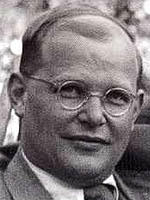Bonhoeffer: Charismatic Professor and Prophet

Yesterday was my first opportunity to introduce Bonhoeffer's Life Together to the campus community. As with many others, I have found his life's story an inspiration which beckons me to be a better and truer theologian, unwilling to simply live life in an ivory tower. What follows is my attempt to set him and his work into its proper historical and cultural context:
In his recent book, Christ Plays in Ten Thousand Places: A Conversation in Spiritual Theology, Eugene Peterson claims that, “Getting saved is easy; becoming a community is difficult—damnably difficult,” (250). Having just come off a lifetime’s project of translating the entirety of the Bible, perhaps no one has a better insight into this theme than does Peterson. For, it is clear as one reads through the story of both the people of Israel and the emerging Christian community that our call to be “little Christ’s” as Martin Luther suggested, is oftentimes thwarted by our own misperception and misunderstanding. Those of us who use the lectionary on a regular basis, are all too aware of this in the readings from recent weeks—whether it be Peter’s unwillingness to believe in a suffering Jesus or the deaf ears of the people of Judah to the prophet’s pleas for repentance and life change.
Dietrich Bonhoeffer, whose book, Life Together, forms the basis for our thinking this semester, came to understand this difference between some kind of initial encounter with the gospel and the necessity of being converted into a Christian community. A classically-trained, brilliant, young German theologian, Bonhoeffer did his academic work in the wake of the destruction of the modern optimism which had characterized life in Europe prior to the Great War. That war resulted in millions of deaths and the loss of an entire generation—mostly men who were just slightly older than Dietrich. While we rightly mourn the loss of lives on 9/11 or in the recent hurricane in the Gulf, the casualties in both were miniscule compared to what Europe lost in the first quarter of the last century. This unprecedented slaughter by those who called themselves “Christian nations,” led to a severe crisis of faith from which the church in Europe has never fully recovered.
The young Bonhoeffer knew that the tired clichés of the past, that the old paradigm for living one’s life, would no longer work. So, in the early 1930’s he began to beckon several of his more serious students at the University of Berlin to a seminary community in Finkenwalde. I picture the young Bonhoeffer as being someone like my colleagues Gene Dunkley or Christina Smerick, who both ooze a kind of charisma that is attractive to impressionable students. Bonhoeffer’s seminars, his open-ended evening discussions, and field trips, all attracted a number of students, many of whom became his closest colleagues in the nascent church struggle. In 1932, these young theology students began to organize frequent weekend trips to a rented cottage in the country to “talk theology,” to engage in rudimentary spiritual exercises, to take long walks in the woods, and to listen to Bonhoeffer’s record collection. The young Dietrich was absolutely enthralled with two forms of classic Americana: the emerging jazz scene and the old African American spirituals. In fact, he had been tempted a few years earlier to accept a post at Union Theological Seminary in New York City, where he had stood out like a sore thumb at Sunday worship in predominantly black churches where segregation was still deeply imbedded in American culture.
As Bonhoeffer and his younger charges listened to records, cavorted through the countryside, and joined together for prayer and reflection, they began to think seriously about how to form authentic Christian communities through a structured spiritual life into which would be integrated appropriate forms of service to people in need. Though these beginnings in community life were informal and spontaneous, they provided the earliest sparks for the creation of the sense of community which was to be front and center on Bonhoeffer’s agenda for the next decade or so. Bonhoeffer had grown restless with those who spoke of Christianity only from their academic ivory towers, but he was also concerned about the “no-nothingism” that was allowing groups like the Nazis to make inroads into the national church. From this point on, he was interested not merely in reflecting upon the church but in being a part of a church-setting committed to God’s Word, accepting the self-sacrifice embodied in the cross of Jesus Christ. His longing for a type of community that was both courageous and obedient would prove fortuitous in the emergence of the crises which came to face the German nation and the world at large over the next ten to fifteen years.


<< Home